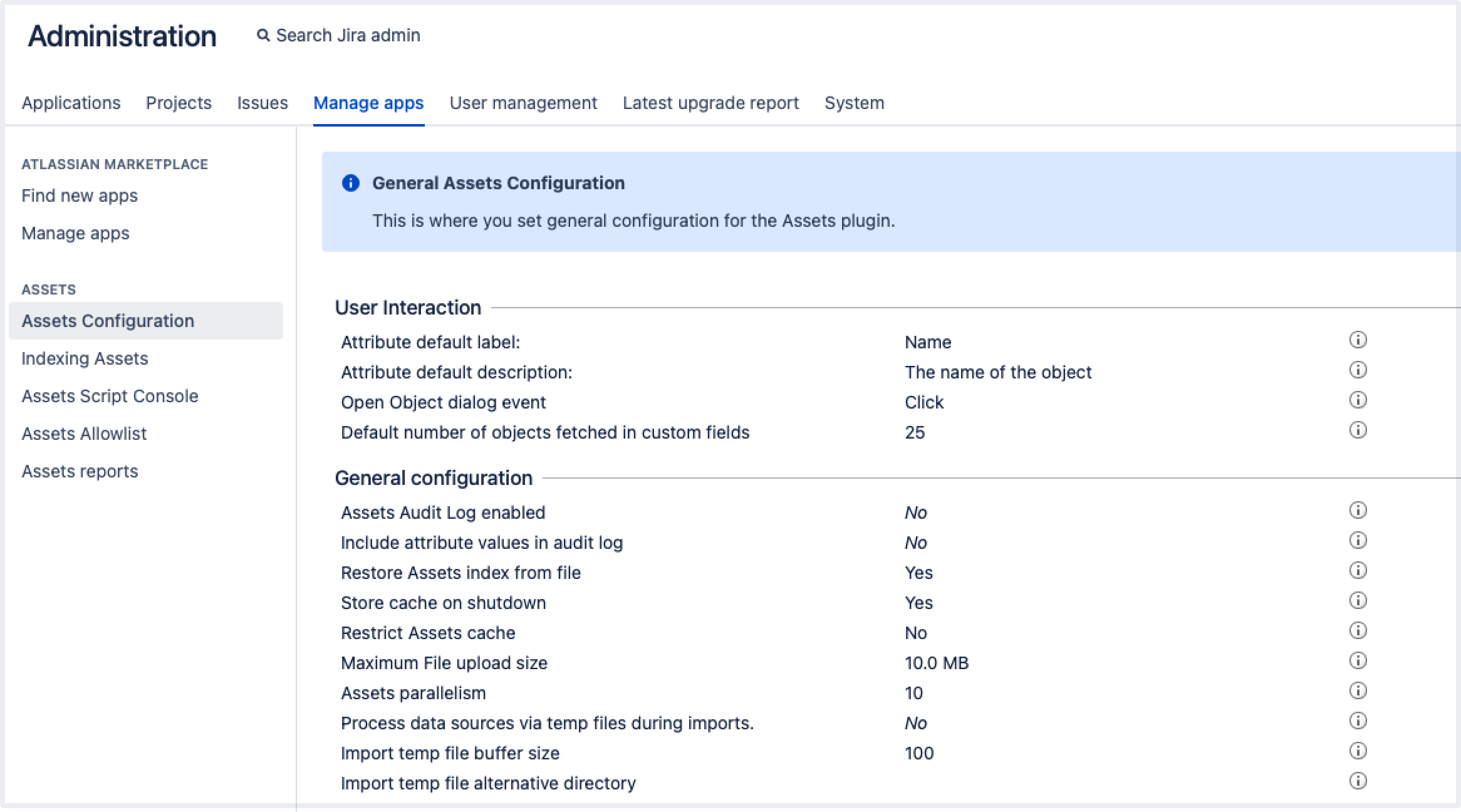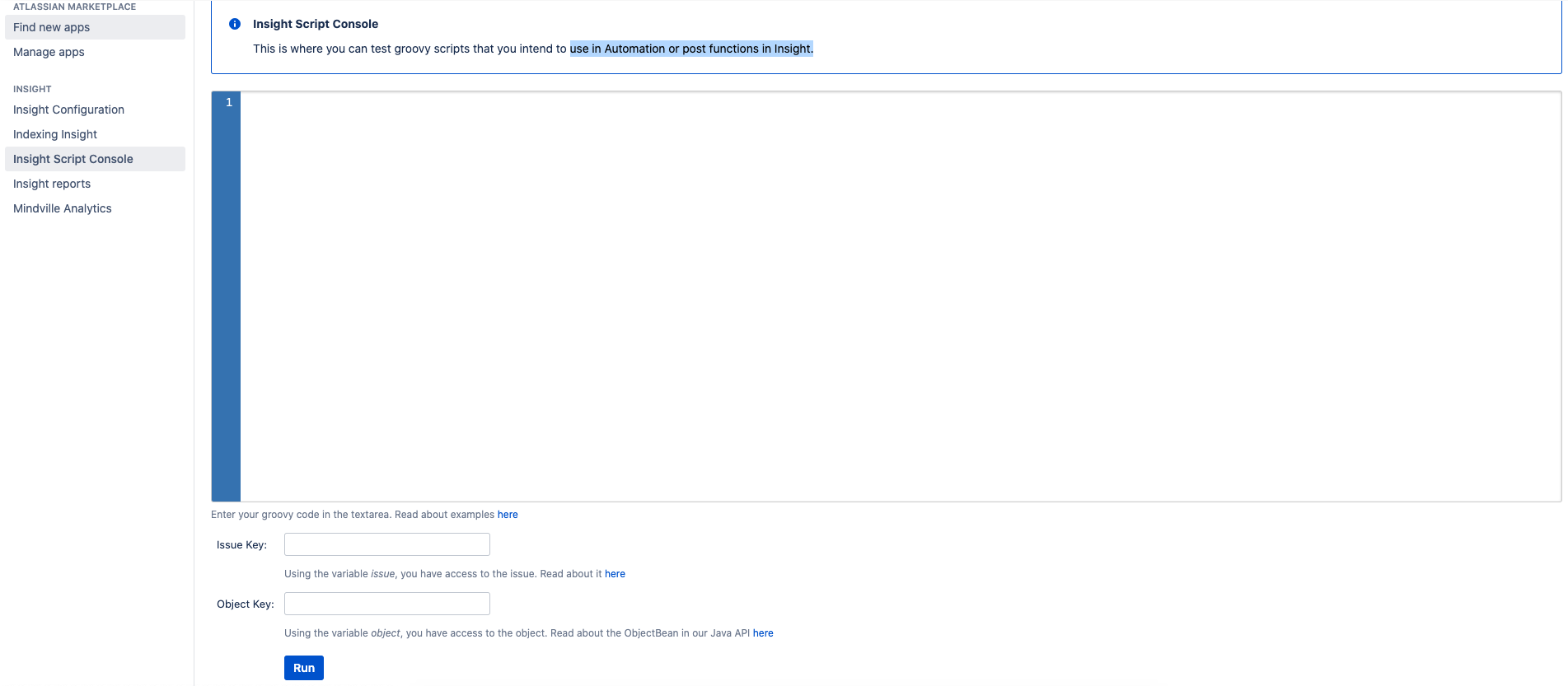グローバル Jira 設定の構成
アセットのグローバル Jira 設定には、オブジェクト スキーム、オブジェクト タイプ、あるいはオブジェクトではなく、アセット アプリ自体の設定が含まれます。ここでは、ログ設定、日時、アセットのインデックス再作成などを設定できます。利用できる設定の詳細については、次をご覧ください。
このページの内容
グローバル Jira 設定にアクセス
アセットのグローバル Jira 設定にアクセスするには、次の手順に従います。
- [管理] > [アプリを管理] の順に移動します。
- [アセット] セクションでページを探します。
一般設定
一般設定を開くには [アセット設定] を選択します。
| 設定 | 説明 |
|---|---|
| ユーザー相互作用 | |
属性の既定ラベル | すべてのオブジェクト タイプの既定のラベルとして使用されるテキスト タイプの属性。これは、特定のオブジェクト タイプ設定でも変更できます。 この設定はこの設定の変更後に作成されるオブジェクト タイプにのみ影響することにご注意ください。 |
属性の既定の説明 | 既定のラベル属性の説明。これは、特定のオブジェクト タイプ設定でも変更できます。 |
[オブジェクトを開く] ダイアログ イベント | ユーザーがオブジェクト リンクを選択、またはユーザーがオブジェクト リンクにカーソルを移動した際に、オブジェクト ダイアログを開くかどうかを決定します。 これは、Jira 課題を表示している際にアセット オブジェクト フィールドを表示する場合にも適用されます。 |
カスタム フィールドで取得されるオブジェクトの既定数 | これは、アセットがリクエストごとにカスタム フィールドで取得するオブジェクトの数を示します。既定値は 25 に設定されています。 ユーザーがカスタム フィールドのオブジェクトの検索を開始すると、検索条件に一致するオブジェクトがサーバーから非同期でフェッチされます。したがって、既定の制限である 25 で十分なはずであり、この値が推奨されます。 この数を増やすとリクエストごとにより多くのオブジェクトをフェッチする必要があるため、パフォーマンスに影響します。 |
| 一般設定 | |
アセット監査ログが有効 | このチェックボックスをオンにすると、すべてのアセット オブジェクト イベントが監査ログファイルに記録されます。 |
属性値を監査ログに含める | このチェックボックスは、上記の [アセット監査ログが有効] がオンになっている場合にのみ有効になります。 オンにすると、監査ログにあるオブジェクトのすべての属性値が含まれます。 |
アセット インデックスをファイルから復元 | This will ensure that on start up, Assets index will be restored from a file. This will help decrease the startup time. アセットは起動時にファイルの整合性チェックをデータベースに対して実行して、一致しない場合はインデックスを再作成します。 これをオフにすると起動時間が遅くなる場合がありますが、壊れたインデックス ファイルがデータの不整合を引き起こす可能性があるリスクを排除できます。 初期設定ではオンになっています。ファイルは {$JIRA_HOME/caches/assets_indexes} にあります。 たとえば、MacOS ではファイルのパスは {/var/atlassian/application-data/jira/caches/assets_indexes} になります。 |
キャッシュをシャットダウン時に保存 | これは、アセットのインデックスをアセットのシャットダウン時にファイルに保持する必要があることを示します (例: プラグインのアップグレード、Jira の再起動、アセットの無効化など)。 [アセット インデックスをファイルから復元] がオンになっている場合は、このプロパティもオンにすることをお勧めします。 |
アセット キャッシュを制限 | これによって、アセットに保存できるオブジェクトの量を制限できます。キャッシュに存在するオブジェクトの数が限られるため、メモリ フットプリントが制限されます。 既定では、アセットを使用する際にキャッシュ内のオブジェクトは制限されず、この方法が推奨されます。制限すると、パフォーマンスに悪影響が及ぼされます。 |
キャッシュに許されるオブジェクトの数 | [アセット キャッシュを制限] がオンになっている場合にのみ有効になります。 このプロパティは、キャッシュに保存されるアセット オブジェクトの数を示します。 推奨される方法は、キャッシュのオブジェクトを制限しないことです。 |
ファイル アップロードの最大サイズ | ファイル、画像、添付ファイルをアセットにアップロードする際の最大サイズ (バイト単位)。 |
アセットの並列処理 | アセットが並列タスク (データのインポート、インデックスの再作成など) を実行するために生成するスレッドの数です。 この数値が低い値に設定されている場合はアセットが Jira にかける負担が軽減します。ただし、パフォーマンス速度は低下します。 |
インポート中にデータ ソースを一時ファイル経由で処理 | インポート中のメモリ フットプリントを減らす目的でインポート モジュールを使用する際に、データをディスク上で一時的に保存します。 |
| カスタム ロケールをアセットに使用 | アセットに保存されているデータを Jira の既定のロケール以外のロケールで並べ替える必要があることを示すために使用されます。 オンにするとオブジェクトのフェッチが遅くなる可能性があるため、パフォーマンスに問題が起こらないように初期設定では無効になっています。 |
| アセットのロケール | [カスタム ロケールをアセットに使用] がオンになっている場合にのみ有効になります。 この設定で、アセットがデータを並べ替える際に使用する言語が決まります。 |
インポートする一時ファイルのバッファ サイズ | 一時ファイルを介してデータ ソースを処理する際に、メモリに保存される項目の最大数 |
インポートする一時ファイルの代替ディレクトリ | 有効な場合、インポート中に一時ファイルをディスクに保存するための代替ディレクトリ。この設定の変更を有効化するには、インスタンスを再起動してください。 |
並行インポートの最大数 | クラスター全体で実行できる並行インポートの数。並行インポートの設定方法についてはこちらをご確認ください。 |
Jira Service Management ポータルの検索テキスト (単一) | Jira Service Desk ポータル上にあるアセット フィールドのプレースホルダー (単一フィールド) |
Jira Service Management ポータルの検索テキスト (複数) | Jira Service Desk ポータル上にあるアセット フィールドのプレースホルダー (複数フィールド) |
| クラスター化された Data Center | |
| スケジュールとインポートの専用ノード | この設定は、マルチノードの Data Center を構成している場合にのみ使用できます。 このノードは、インポーター、自動化、手動インポートなど、アセットのスケジューリング タスクを実行するための専用ノードになります。 ノードがスケジュールの専用ノードとして選択されてスケジュールされたタスクの実行時に利用できなくなった場合、そのタスクは実行されないことにご注意ください。 |
| 進行中アクションのステータス更新頻度 | |
| オブジェクト インデックスのレプリケーション | |
| オブジェクト読み込みの再試行回数 | データベースからオブジェクトを読み込む試行回数。 |
| オブジェクト読み込みの再試行間隔 (ミリ秒) | オブジェクトの読み込みを試行する間隔。 |
| 送信者キューのサイズ | レプリケーション メッセージの作業キューのサイズ。この設定の変更を有効化するには、インスタンスを再起動する必要があります。 |
| 送信者スレッドの数 | レプリケーション メッセージをバッチ処理および送信するためのスレッドの数。この設定の変更を有効化するには、インスタンスを再起動する必要があります。 |
| 最大バッチ サイズ | まとめて 1 つのメッセージにバッチ処理される変更の最大数。 |
| バッチ処理遅延 (ミリ秒) | 変更の完了後、作業キューからバッチ処理して送信するまで待機するための遅延。 |
| 受信者キューのサイズ | レプリケーション メッセージを受信するためのキューのサイズ。この設定の変更を有効化するには、インスタンスを再起動する必要があります。 |
| 受信者スレッドの数 | 受信者のキューから読み取るスレッドの数。この設定の変更を有効化するには、インスタンスを再起動する必要があります。 |
| 再試行キュー スレッドの数 | 再試行キューをポーリングするスレッドの数。この設定の変更を有効化するには、インスタンスを再起動する必要があります。 |
| 再試行回数 | 最初に通知が届いたときにデータベースからオブジェクトを読み取る準備ができていない場合に、再試行キューから再試行する回数。 |
| 再試行キューの間隔 (ミリ秒) | 再試行キューからメッセージを再試行するまで待機する間隔。 |
| デッドレター キューの記録間隔 (ミリ秒) | デッドレター キューの内容を確認してから、キューに問題がある場合にエラーを記録するまでの間隔。 |
日付の設定
アセットのすべての日付は Jira 管理者設定を使用しています。次の URL で変更できます。
https://host:port/secure/admin/AdvancedApplicationProperties.jspaログ ファイル
ログは次のディレクトリにあります。
<Jira-shared-home>/log添付ファイル
アセットの添付ファイルは、次のディレクトリの avatars、files、icons、objects という名前のサブフォルダーにそれぞれ保存されます。
<Jira_home>/data/attachments/assetsインデックス作成
インデックス設定を開くには [アセットのインデックス化] を選択します。
インデックス作成では次のオプションから選択できます。
- Clean re-index
A clean re-index means that all objects will be removed from the index across all nodes, and then will be indexed again. This is recommended if you want to have a fresh state of the index. Once the indexing is in progress, you won't be able to cancel it or search for objects or filter them. - 再インデックス化
この処理ではすべてのオブジェクトをインデックスに残した上で、アセットが再度インデックスを作成します。処理中もオブジェクトを検索できます。 - アセット インデックスをファイルに永続化
ディスク上のインデックスを手動で保持 (コピー) できます。多数のオブジェクトを含む大規模なアセット環境があり、アプリの再インストールを計画している場合に役立ちます。インデックスをディスク上に置いておけば、アセットでゼロから作り直す必要はありません。
Groovy スクリプトのテスト
Groovy スクリプトをテストするには [アセット スクリプト コンソール] を選択します。これによって、アセットの自動化や事後操作で使用する Groovy スクリプトをすばやく簡単にテストできます。
レポートの同期
レポートの同期設定を開くには [アセット レポート] を選択します。ここでは、レポートのデータを同期する cron スケジュールを設定できます。
Analytics
アナリティクスの設定を開くには [Mindville アナリティクス] を選択します。
Data Center に関するその他の設定
clustermessage テーブルのデータ保持期間を設定する
データ保持期間を設定すると、clustermessage テーブルの過負荷に起因するパフォーマンスの問題を回避できます。大量のデータセットを短時間でアセットにインポートすると、clustermessage テーブルに情報が入力されてパフォーマンスの問題が発生する可能性があります。
データ保持期間を設定するには、次の手順に従います。
- [管理] > [システム] の順に移動します。
- [詳細] セクションまで下にスクロールして [サービス] を選択します。
- [サービスを追加] の [クラス] で [Build-in services (組み込みサービス)] を選択します。
- [クラスター メッセージ フラッシュ サービス] を選択します。
- 以下の情報を入力します:
- 名前 - クラスター メッセージ フラッシュ サービス
- クラス - com.atlassian.jira.service.services.cluster.ClusterMessageCleaningService
- スケジュール - 0 0 4/12 * * ?
- [サービスを追加] を選択します。
- [保存期間] に「2880m」と入力します。
- 更新を選択します。
[プロセスの結果] タブの更新頻度を設定する
この設定は、マルチノードの Data Center を構成している場合にのみ使用できます。
インポートの進捗は、[アセット設定] で設定できる実行作業単位の数に応じて、データベース全体で共有されます。作業単位は、進行中の操作におけるデータベース更新頻度を定量化するものです。ユーザー エクスペリエンスのパフォーマンスに問題があることに気づいた場合にのみ、この値を変更することをお勧めします。
たとえば、CSV インポートの場合、作業単位は CSV ファイルの 1 つの行 (アセット オブジェクト) を表します。間隔を 100 作業単位とした場合、新しいオブジェクトが 100 個インポートされるたびに、インポート操作のステータスがデータベースで更新されます。
既定の作業単位数は 100 です。この値を変更するには、次の手順に従います。
- [管理] > [アプリを管理] の順に移動します。
- 左側のパネルで、[アセット設定] を選択します。
- [Edit settings] を選択します。
- [データ センター] セクションで、[進行中アクションのステータス更新頻度] の値を編集します。
- [保存] を選択します。
Assets index validation properties
The following properties control the Assets indexing process.
既定値 | Reloads at runtime | 説明 | Why you might change this |
|---|---|---|---|
Sender queue size: | |||
10000 | いいえ | The | Set this value large enough to ensure saving object isn’t blocked and to keep the queue drained by the threads. If you see that the queue is getting close to its maximum capacity, increasing its size can help reduce the strain on the parts of the system that send data into the queue. Increasing the queue size might require additional JVM memory, depending on its current availability. |
Sender threads: | |||
5 | いいえ | Specifies the number of sender threads polling the This property is used with the Sender queue size ( | If your instance is handling large imports and bulk changes, increasing this value can help process messages faster. This helps to reduce the work queue size quicker. However, setting the value too high will result in smaller batches and negate the effect of delaying and batching updates into a single message. For more details, check the Maximum batch size and Batching delay properties. |
Maximum batch size: | |||
1000 | はい | Determines the maximum number of object IDs added to You can observe batch sizes in the logs and Java Management Extensions (JMX). For example, in the debug log for
Additionally, the debug logs for
| If all messages consistently reach the current maximum batch size, it means that replication is struggling to keep up. However, we don't recommend setting this value above 1000 because some databases, like Oracle, have update limits. |
Batching delay: | |||
400ms | はい | Specifies the delay between when an item becomes available on a work queue and when the queue is processed. This delay allows the queue to populate, optimizing the batch for bulk creates, updates, and deletes. Increasing the delay can create larger batches but also increase the time it takes for updates to appear on other nodes in the cluster. | If you notice that batches are small, you can increase the delay to allow more time for larger batches to form. If batches are nearing the maximum size set in |
Object load retry attempts: | |||
200 | はい | Specifies the number of attempts to check the database for an object during its creation if the message is processed before the database transaction is completed. This applies to both additions and updates within the object index when rendering the object. | If you receive messages before they exist in the database and they end up in the dead-letter queue (DLQ), you can increase this setting along with the delay set in |
Object load retry interval: | |||
100ms | はい | Determines the delay between attempts to load objects for adds and updates in the object index. | Use this property together with c We don’t recommend reducing this value below 100 ms because it’ll increase the database querying load. |
Receiver queue size: | |||
10000 | いいえ | Specifies the maximum size of the work queue for adding messages to be processed on the receiving nodes. The changes are batched into a single | If you allow the queue to fill up for too long, it can block TCP connections from the Atlassian cache, slowing down other operations, such as index replication. On the other hand, if the queue is unbounded, it can consume excessive memory. |
Receiver threads: | |||
5 | いいえ | Specifies the number of threads polling the | If you have enough computing resources available, you can increase this value to enhance the processing of the queue that contains received messages. This will unblock Jira TCP threads quicker. |
Retry queue threads: | |||
2 | いいえ | Specifies the number of threads polling the retry queue in | If your instance handles a high number of failures, consider increasing this value. Failures might happen because the database doesn't update as quickly as the replication process, causing the retry queue to drain slowly. |
Retry attempts: | |||
10 | はい | Specifies the number of retry attempts from the retry queue. This determines how many times a failed message is placed back onto the retry queue before it’s moved to the dead-letter queue (DLQ). | Increase this value if you think more retry attempts could lead to successful message processing, such as when you expect database delays. |
Retry queue interval: | |||
60000 ms (1 min) | はい | Specifies the interval between retry attempts for a message after its last retry. A delay ensures there's enough time for the system to catch up with database updates. During each retry attempt, the object index enters a retry cycle according to the values set for the | Use this property together with |
Dead-letter queue (DLQ) logging interval: | |||
300000 ms (5 min) | はい | Specifies the interval at which the DLQ is checked for items and a warning is logged. If debug logging is enabled on | If you need to see the DLQ changes faster, decrease the interval. |





